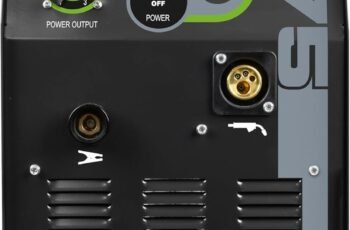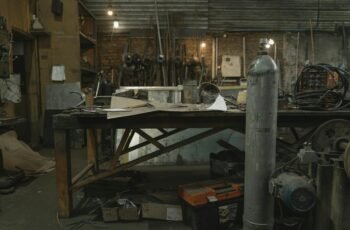Ad Blocker Detected
Our website is made possible by displaying online advertisements to our visitors. Please consider supporting us by disabling your ad blocker.
When you’re weighing inverter versus transformer welding machines, it’s essential to consider what each offers. Inverters boast high efficiency and portability, making them perfect for precise work. On the other hand, transformers are rugged, providing reliable power for heavy-duty tasks. Each has distinct advantages tailored to specific needs, so understanding these differences can guide you in making the right choice for your welding projects. Which suits your task best?
Power Efficiency and Energy Consumption
When choosing between inverter and transformer welding machines, understanding power efficiency and energy consumption is crucial.
Inverters shine with 90%–95% efficiency due to high-frequency conversion, while transformers lag at 55%–65% because of resistive losses.
If you’re targeting a 140A output, inverters consume just 280W–320W compared to transformers’ hefty 500W–550W demand.
This translates to inverters saving you 10%–20% in energy costs over time. They also dissipate less heat, losing only a fraction of the 200W that transformers shed during operation.
With their compact design, inverters are not only energy-efficient but also easier to transport, making them ideal for field applications.
With dual-voltage capabilities, inverters adapt easily to 110V or 220V circuits, unlike transformers, which often need 220V+ connections.
These factors make inverters a more energy-efficient and cost-effective choice for most settings.
Arc Performance and Welding Capabilities
Although choosing between inverter and transformer welding machines can be challenging, focusing on arc performance and welding capabilities highlights the advantages of inverters.
These machines excel with advanced microcontrollers, allowing real-time arc adjustments for stable and precise welding. You’ll appreciate the dynamic response to arc changes, ensuring consistent heat input and reducing spatter. Inverter welding machines also offer improved efficiency and compact design, which is a result of modern technology advancements.
Inverters also support multi-mode capabilities, letting you tackle TIG, MIG, and more with ease. Their ability to maintain a stable arc, even with fluctuating power sources, enhances your welding experience, especially on thin-gauge metals or complex joints.
With programmable settings and simplified controls, inverters make it easier for beginners to achieve quality welds while offering seasoned operators the flexibility and precision they need.
Physical Characteristics and Portability
Inverter welding machines stand out with their compact and lightweight designs, making them much easier to handle and transport compared to their bulkier transformer counterparts. By utilizing smaller high-frequency transformers and compact electronics, inverters reduce physical dimensions, ditching the heavy magnetic cores and layered windings of traditional models. This design approach means they weigh 20-30% less, enhancing portability and ease of transport. Ergonomic handles and balanced weighting further improve maneuverability. Inverter welders also integrate cooling systems like fans and airflow grates, maintaining performance without adding bulk. Their modular construction simplifies maintenance, ideal for mobile work environments. Plus, they fit conveniently in toolboxes or vehicles, offering unmatched on-site applicability and storage benefits over conventional transformer units. Additionally, the advanced features of inverter welders, such as Hot Start and Pulse Welding, contribute to their superior efficiency and user-friendliness.
Environmental Tolerance and Reliability
While inverter welding machines impress with their portability and modern design, environmental tolerance and reliability tell a different story.
Transformer machines consistently outperform inverters in harsh conditions like dust, wind, and moisture. They undergo rigorous testing and are preferred for rugged workplaces, maintaining performance in fluctuating temperatures. Transformer welders also provide reliable power output suitable for demanding industrial tasks, which contributes to their preference in such challenging environments.
In contrast, inverters, though improved, remain sensitive to environmental factors, requiring additional protective measures and regular maintenance.
Transformers, with their robust components, need minimal maintenance and offer longer service lifespans. They excel in extreme heat and cold, operating reliably without performance dips.
Inverters, on the other hand, risk failure from humidity, dust, and temperature changes, often needing costly repairs. For consistent welded output in adverse conditions, transformers are your reliable choice.
Cost and Application Considerations
When weighing the cost and application of welding machines, it’s clear that both inverter and transformer models offer unique advantages.
Inverters demand a higher initial investment, ranging from $800 to $3,000+, but they save 20-30% in power consumption for frequent users and consolidate multiple welding processes into one machine. Miller’s PR team is actively working on articles about the energy efficiency and productivity benefits of inverters, highlighting their advanced AC controls that enhance overall welding quality.
Transformers, with lower acquisition costs of $500 to $2,000, are ideal for budget-conscious buyers and excel in high-amperage tasks like welding thick steel.
In terms of application, inverters provide versatility, handling TIG, MIG, and stick welding, and are perfect for multi-site operations.
They’re also efficient, consuming less power and offering precise control for delicate materials.
Meanwhile, transformers are robust, long-lasting, and better suited for heavy-duty fabrication needs.
Conclusion
When choosing between inverter and transformer welding machines, consider your specific needs. If you prioritize energy efficiency, precision, and portability, go for an inverter. It’s perfect for multi-site operations and delicate work. However, if you need a robust machine for heavy-duty applications in harsh environments, a transformer might be your best bet. It’s reliable but less energy-efficient. Ultimately, weigh the cost and application to determine which machine will best suit your welding tasks.



